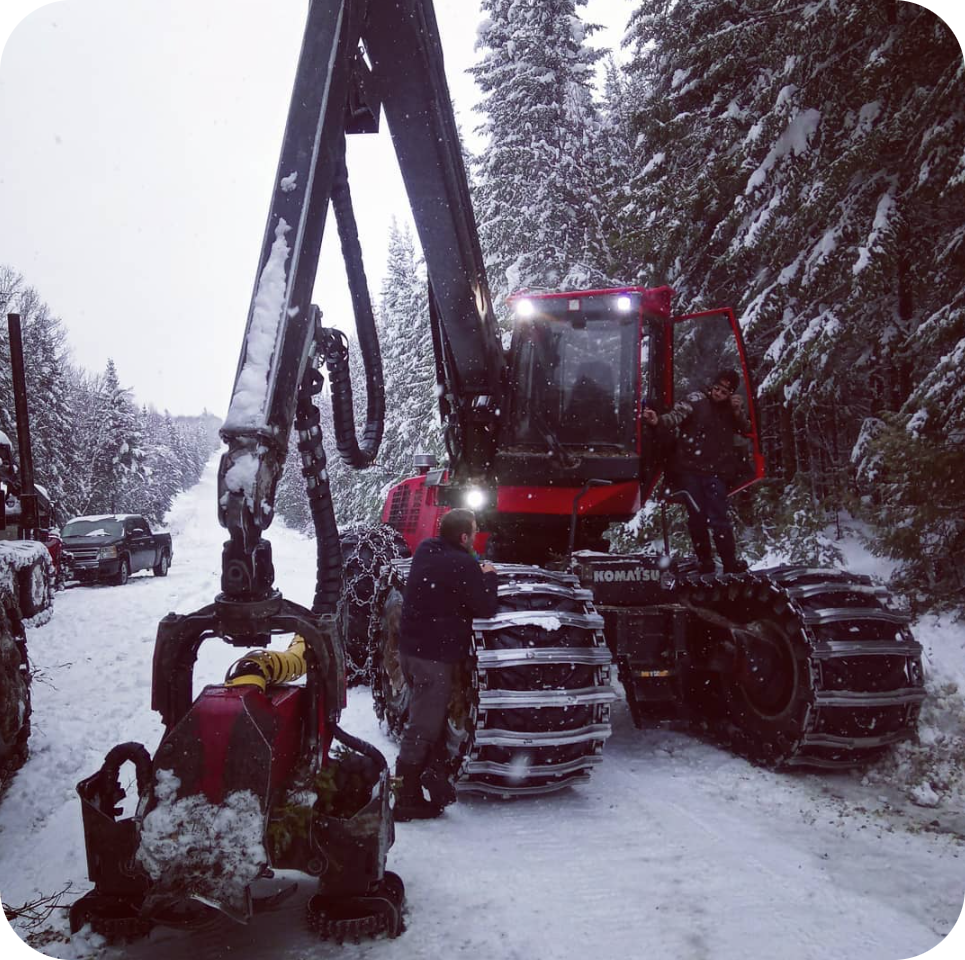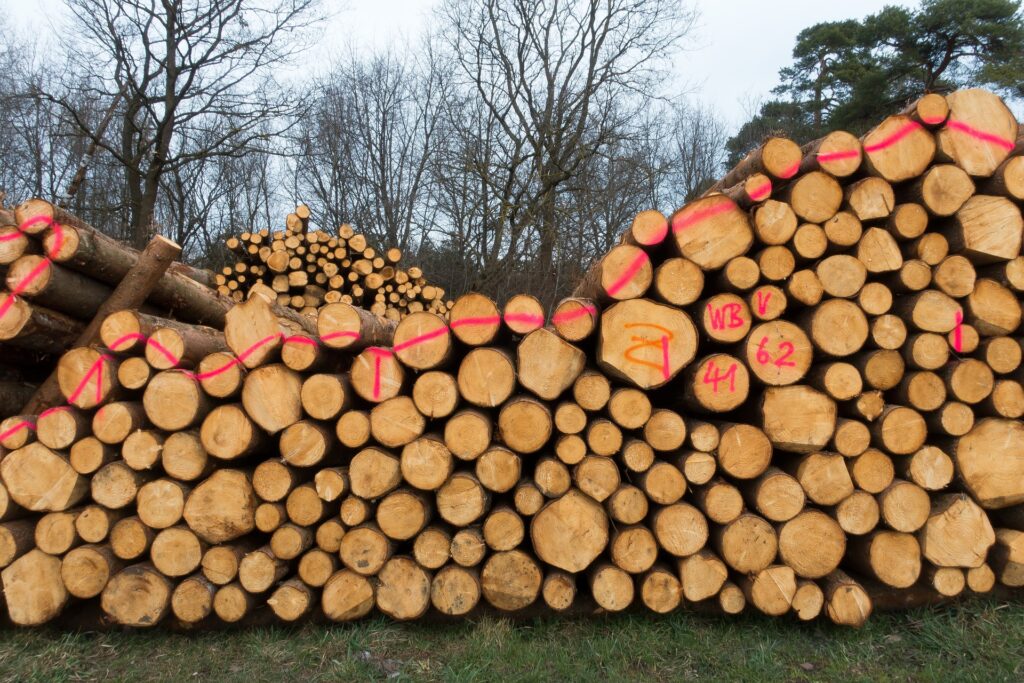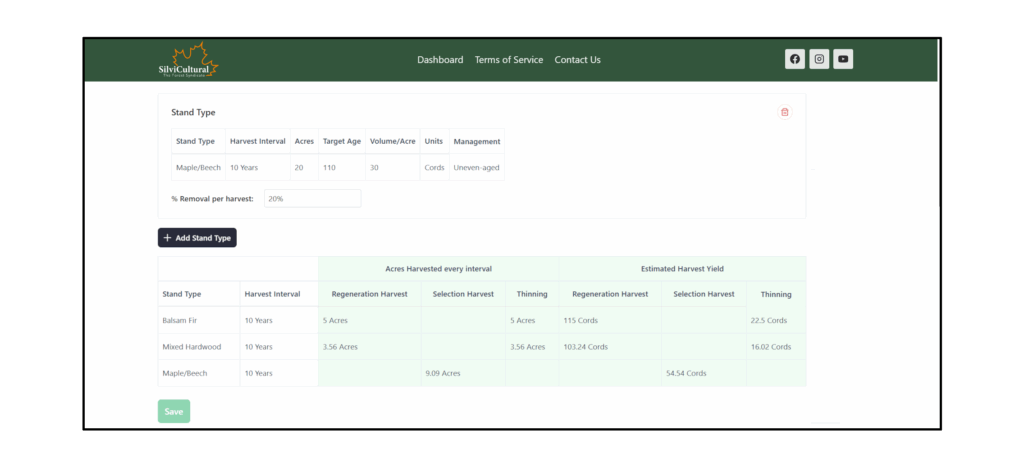Sustainable Harvesting: Understanding Area Control vs. Volume Control Methods
For woodland owners who want to generate income from their forest while ensuring it remains healthy and productive for future generations, sustainable harvesting is the foundation of responsible forest management. But what does “sustainable” actually mean in practice, and how do you calculate how much timber you can safely harvest each year?
The answer lies in choosing the right regulatory method—a systematic approach to determining sustainable harvest levels. In this guide, we’ll explore the two primary methods of sustainable harvesting: area control and volume control. We’ll examine how each works, their respective advantages and disadvantages, and why area control is often the better choice for most private landowners.

What Is Sustainable Harvesting?
Sustainable harvesting means removing timber at a rate that doesn’t exceed the forest’s ability to regenerate and grow. The goal is to maintain or enhance the forest’s long-term productivity, ensuring you can continue harvesting indefinitely without degrading the resource.
Think of it like managing a financial investment. You want to harvest the “interest” (growth) without depleting the “principal” (the growing stock). A truly sustainable harvest allows you to generate consistent revenue while maintaining a healthy forest that continues to provide timber, wildlife habitat, watershed protection, and other ecosystem services.
The challenge is determining exactly how much you can harvest without crossing that sustainability threshold. This is where regulatory methods come in—mathematical frameworks that help you calculate sustainable harvest levels based on forest conditions and management objectives.
Area Control: Harvesting Based on Acreage
Area control, also called area regulation, is the simpler and more intuitive of the two main sustainable harvesting methods. The basic principle is straightforward: you divide your total forest acreage by your desired rotation age, then harvest that many acres each year.

How Area Control Works
Here’s the formula: Annual Harvest Area = Total Forest Area ÷ Rotation Age
For example, if you own 100 acres of forestland and want to harvest trees at 50 years of age, you would harvest 2 acres per year (100 ÷ 50 = 2). Over 50 years, you’d cycle through your entire forest, harvesting each stand once at the target age.
The beauty of area control is its conceptual simplicity. You’re not trying to calculate volumes, growth rates, or complex equations—you’re simply ensuring that you harvest an equal portion of your forest each period. As long as each harvested area regenerates successfully, you maintain a continuous supply of timber at your desired harvest age.
Area control works particularly well for even-aged management, where you clear-cut or heavily harvest a stand and then regenerate it all at once. Over time, this creates a regulated forest with stands distributed across all age classes from seedlings to mature timber ready for harvest.
Advantages of Area Control
Simplicity: The math is straightforward and easy to explain. Any landowner can understand dividing total acres by rotation age, making it accessible without advanced forestry training.
Ease of Implementation: You don’t need detailed timber cruises or sophisticated volume calculations. A basic stand map with acreage estimates and age classes is sufficient to get started.
Consistency and Predictability: You harvest roughly the same acreage each period, making it easy to plan logging operations, budget for revenue, and schedule regeneration activities.
Visual Clarity: It’s easy to see and communicate your management approach. You can point to a map and show which stands will be harvested when, making planning transparent for family members, heirs, or partners.
Natural Sustainability: If all harvested acres regenerate successfully to the same productivity level, sustainability is essentially guaranteed. The system self-corrects over time.
Lower Inventory Costs: You don’t need frequent, detailed timber inventories to maintain the system. Basic acreage tracking and age class monitoring are usually sufficient.
Disadvantages of Area Control
Site Productivity Variations: Not all acres are equally productive. Two acres might contain vastly different timber volumes depending on soil quality, species, and growing conditions. Area control doesn’t account for these differences.
Market Inflexibility: You’re committed to harvesting specific acres in specific years, which might not align with market conditions. If prices are low when a stand is scheduled for harvest, you have limited flexibility to wait.
Assumes Successful Regeneration: The system assumes harvested areas regenerate to full productivity. If regeneration fails or is delayed, future harvest levels won’t be sustainable.
Less Precise Volume Control: If you need to produce a specific timber volume each year for mill contracts or cash flow requirements, area control provides less precision than volume-based methods.
Despite these limitations, area control remains the gold standard for most private woodland owners because its advantages far outweigh its drawbacks in typical scenarios.
Volume Control: Harvesting Based on Growth
Volume control, also called volume regulation, takes a fundamentally different approach to sustainable harvesting. Instead of focusing on acres harvested, it focuses on timber volume—specifically, ensuring that the volume harvested doesn’t exceed the volume being grown.
How Volume Control Works
The basic formula for volume control is: Annual Allowable Cut = Annual Growth + (Current Volume – Target Volume) ÷ Adjustment Period
This method requires detailed knowledge of:
- Current standing timber volume across your forest
- Annual growth rates by species and stand
- Your target volume (desired future stocking level)
- The time period over which you want to adjust toward that target
For example, if your forest grows 1,000 cords per year, currently contains 30,000 cords, and you want to maintain 25,000 cords, you might harvest 1,250 cords annually for 10 years (1,000 in growth + 5,000 excess ÷ 10 years = 1,250). After 10 years, you’d stabilize at harvesting 1,000 cords annually—the growth rate.
Advantages of Volume Control
Volume Precision: If you need to produce specific timber volumes for contracts, cash flow, or markets, volume control gives you that precision.
Accounts for Site Productivity: High-quality sites producing more volume contribute more to the allowable cut, while poor sites contribute less, creating a more economically efficient harvest pattern.
Flexibility in Stand Selection: As long as you stay within your total volume limit, you have flexibility in which stands to harvest, allowing you to respond to market conditions, operational constraints, or changing objectives.
Better for Uneven-Aged Management: Volume control works well for selection harvesting and uneven-aged systems where you’re removing individual trees rather than clear-cutting entire stands.
Responsive to Inventory Changes: If growth rates increase (due to improved practices) or decrease (due to damage), the system adjusts allowable cut accordingly.
Disadvantages of Volume Control
Complexity: Calculating sustainable harvest volumes requires detailed timber inventories, growth projections, and regular re-measurement. This demands significant expertise and investment.
Higher Costs: Maintaining the detailed volume data needed for volume control is expensive. You need periodic timber cruises by professional foresters, which can cost thousands of dollars.
Data Uncertainty: Growth rate estimates are just that—estimates. Weather, pests, disease, and other factors create uncertainty. Small errors in growth assumptions compound over time, potentially leading to overharvesting.
Implementation Challenges: Landowners need to track volumes across multiple stands, species, and products, requiring sophisticated record-keeping systems.
Less Intuitive: Most landowners find it harder to visualize and understand volume control compared to the straightforward acreage approach of area control.
Temptation to Overharvest: If volume calculations show you “can” harvest a certain amount, there’s temptation to maximize that harvest even if operational or ecological factors suggest restraint.
Why SilviCultural Recommends Area Control for Most Landowners
While volume control has its place—particularly for large industrial forests with professional management staff—area control is the better choice for the majority of private landowners. Here’s why:
Reliability and Accuracy: Area control’s simplicity makes it less prone to errors. You’re not relying on growth estimates that might be wrong or inventory data that might be outdated. Acres are acres, and as long as regeneration is successful, the system works.
Cost-Effectiveness: Area control eliminates the need for expensive, repeated timber inventories. Your investment goes toward actual management activities rather than data collection.
Ease of Implementation: You don’t need to be a professional forester to implement area control. With basic maps and age information, you can develop a workable plan and adjust as you learn.
Long-Term Sustainability: Area control naturally creates age-class diversity across your property. Over time, you’ll have stands of all ages from recent regeneration to mature timber, providing continuous harvest opportunities and diverse wildlife habitat.
Family Succession: Area control plans are easy to explain and transfer to the next generation. Your heirs can understand and continue the management approach without specialized training.
For these reasons, SilviCultural’s harvest planning framework emphasizes area control as the foundation of sustainable harvesting for private woodland owners.
Using SilviCultural’s Harvest Planning Tool

To make area control even more accessible, SilviCultural provides an intuitive harvest planning tool directly on your dashboard. This tool helps you calculate exactly how many acres you can sustainably harvest each year or at whatever interval you prefer, based on stand-specific age targets.
The tool accommodates both simple and complex management scenarios. You can work with broad stand classifications like “hardwood” and “softwood” or break your forest into more detailed categories based on species, site quality, or management objectives.
The tool supports both even-aged management (where you harvest entire stands periodically) and uneven-aged approaches (where you conduct partial harvests more frequently). You can even account for intermediate thinning entries, estimating the volume and revenue from pre-commercial and commercial thinnings before final harvest.
By entering basic information—your harvest interval, total acres for each stand type, target harvest age, and expected volume per acre—the tool calculates a sustainable harvest schedule that ensures you’re not depleting your forest resource. The framework provides reliable guidance for maintaining consistent, sustainable harvesting over the long term.
To get the most accurate volume estimates for your planning, you can use SilviCultural’s forest growth tool in conjunction with the harvest planner, ensuring your projections reflect realistic expectations for your specific forest conditions.
Getting Started with Sustainable Harvesting
Whether you’re planning your first timber harvest or trying to formalize a more systematic approach to ongoing harvests, implementing sustainable harvesting practices protects both your forest’s long-term health and your long-term income potential.
Start by identifying your distinct forest stands and estimating their ages and acreages. Decide on a reasonable rotation age—the age at which you want to harvest your trees. This varies by species, management objectives, and markets, but typical rotations range from 30-40 years for pine plantations to 60-80 years for hardwood sawtimber.
Next, use an area control framework to calculate your sustainable annual or periodic harvest acreage. Log into your SilviCultural dashboard and use the harvest planning tool to formalize these calculations and explore different scenarios.
Remember that sustainable harvesting isn’t just about the math—it’s also about executing high-quality harvests that protect soil, water, and residual trees, and ensuring successful regeneration after harvest. Work with qualified consulting foresters and responsible logging contractors to ensure your sustainable harvesting plan translates into sustainable forestry on the ground.
Conclusion
Sustainable harvesting is the cornerstone of responsible forest ownership, allowing you to generate income while maintaining a healthy, productive forest for future generations. While both area control and volume control can achieve sustainability, area control’s simplicity, reliability, and ease of implementation make it the superior choice for most private landowners.
By embracing area control methods and using tools like SilviCultural’s harvest planning dashboard, you can confidently develop a sustainable harvest schedule that balances your financial objectives with long-term forest stewardship. The result is a forest that continues to provide value—economic, ecological, and personal—for decades to come.
